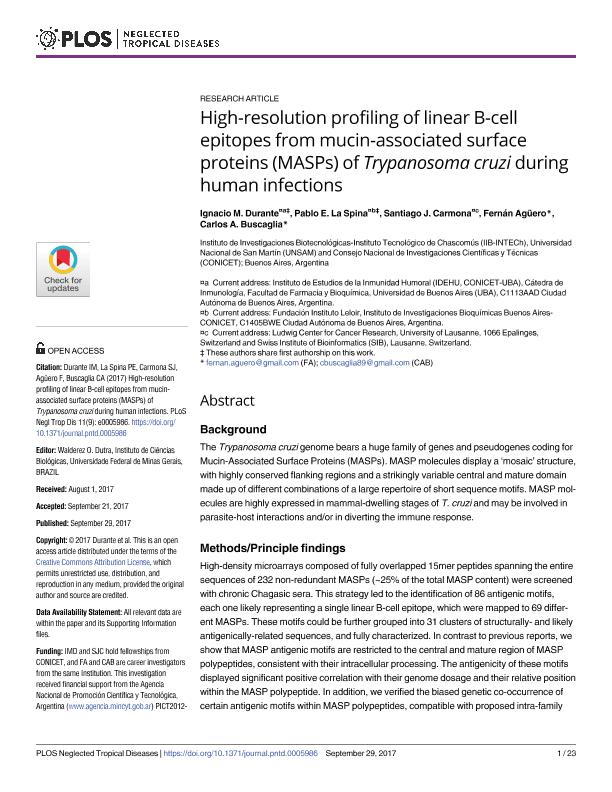Mostrar el registro sencillo del ítem
dc.contributor.author
Durante, Ignacio Miguel

dc.contributor.author
la Spina, Pablo Ezequiel

dc.contributor.author
Carmona, Santiago Javier

dc.contributor.author
Agüero, Fernan Gonzalo

dc.contributor.author
Buscaglia, Carlos Andres

dc.date.available
2018-06-04T15:00:26Z
dc.date.issued
2017-09
dc.identifier.citation
Durante, Ignacio Miguel; la Spina, Pablo Ezequiel; Carmona, Santiago Javier; Agüero, Fernan Gonzalo; Buscaglia, Carlos Andres; High-resolution profiling of linear B-cell epitopes from mucin-associated surface proteins (MASPs) of Trypanosoma cruzi during human infections; Public Library of Science; Neglected Tropical Diseases; 11; 9; 9-2017; 1-23
dc.identifier.issn
1935-2735
dc.identifier.uri
http://hdl.handle.net/11336/47129
dc.description.abstract
Background: The Trypanosoma cruzi genome bears a huge family of genes and pseudogenes coding for Mucin-Associated Surface Proteins (MASPs). MASP molecules display a ?mosaic? structure, with highly conserved flanking regions and a strikingly variable central and mature domain made up of different combinations of a large repertoire of short sequence motifs. MASP molecules are highly expressed in mammal-dwelling stages of T. cruzi and may be involved in parasite-host interactions and/or in diverting the immune response. Methods/Principle findings: High-density microarrays composed of fully overlapped 15mer peptides spanning the entire sequences of 232 non-redundant MASPs (~25% of the total MASP content) were screened with chronic Chagasic sera. This strategy led to the identification of 86 antigenic motifs, each one likely representing a single linear B-cell epitope, which were mapped to 69 different MASPs. These motifs could be further grouped into 31 clusters of structurally- and likely antigenically-related sequences, and fully characterized. In contrast to previous reports, we show that MASP antigenic motifs are restricted to the central and mature region of MASP polypeptides, consistent with their intracellular processing. The antigenicity of these motifs displayed significant positive correlation with their genome dosage and their relative position within the MASP polypeptide. In addition, we verified the biased genetic co-occurrence of certain antigenic motifs within MASP polypeptides, compatible with proposed intra-family recombination events underlying the evolution of their coding genes. Sequences spanning 7 MASP antigenic motifs were further evaluated using distinct synthesis/display approaches and a large panel of serum samples. Overall, the serological recognition of MASP antigenic motifs exhibited a remarkable non normal distribution among the T. cruzi seropositive population, thus reducing their applicability in conventional serodiagnosis. As previously observed in in vitro and animal infection models, immune signatures supported the concurrent expression of several MASPs during human infection. Conclusions/Significance: In spite of their conspicuous expression and potential roles in parasite biology, this study constitutes the first unbiased, high-resolution profiling of linear B-cell epitopes from T. cruzi MASPs during human infection.
dc.format
application/pdf
dc.language.iso
eng
dc.publisher
Public Library of Science
dc.rights
info:eu-repo/semantics/openAccess
dc.rights.uri
https://creativecommons.org/licenses/by-nc-sa/2.5/ar/
dc.subject
Trypanosoma Cruzi
dc.subject
Chagas Disease
dc.subject
Masp
dc.subject
Epitopes
dc.subject
Antigens
dc.subject.classification
Otras Ciencias Biológicas

dc.subject.classification
Ciencias Biológicas

dc.subject.classification
CIENCIAS NATURALES Y EXACTAS

dc.title
High-resolution profiling of linear B-cell epitopes from mucin-associated surface proteins (MASPs) of Trypanosoma cruzi during human infections
dc.type
info:eu-repo/semantics/article
dc.type
info:ar-repo/semantics/artículo
dc.type
info:eu-repo/semantics/publishedVersion
dc.date.updated
2018-06-01T19:22:59Z
dc.journal.volume
11
dc.journal.number
9
dc.journal.pagination
1-23
dc.journal.pais
Estados Unidos

dc.journal.ciudad
San Francisco
dc.description.fil
Fil: Durante, Ignacio Miguel. Consejo Nacional de Investigaciones Científicas y Técnicas. Oficina de Coordinación Administrativa Houssay. Instituto de Estudios de la Inmunidad Humoral Prof. Ricardo A. Margni. Universidad de Buenos Aires. Facultad de Farmacia y Bioquímica. Instituto de Estudios de la Inmunidad Humoral Prof. Ricardo A. Margni; Argentina
dc.description.fil
Fil: la Spina, Pablo Ezequiel. Fundación Instituto Leloir; Argentina
dc.description.fil
Fil: Carmona, Santiago Javier. Universite de Lausanne; Suiza
dc.description.fil
Fil: Agüero, Fernan Gonzalo. Consejo Nacional de Investigaciones Científicas y Técnicas. Centro Científico Tecnológico Conicet - La Plata. Instituto de Investigaciones Biotecnológicas. Universidad Nacional de San Martín. Instituto de Investigaciones Biotecnológicas; Argentina
dc.description.fil
Fil: Buscaglia, Carlos Andres. Consejo Nacional de Investigaciones Científicas y Técnicas. Centro Científico Tecnológico Conicet - La Plata. Instituto de Investigaciones Biotecnológicas. Universidad Nacional de San Martín. Instituto de Investigaciones Biotecnológicas; Argentina
dc.journal.title
Neglected Tropical Diseases

dc.relation.alternativeid
info:eu-repo/semantics/altIdentifier/doi/https://dx.doi.org/10.1371/journal.pntd.0005986
dc.relation.alternativeid
info:eu-repo/semantics/altIdentifier/url/http://journals.plos.org/plosntds/article?id=10.1371/journal.pntd.0005986
Archivos asociados
